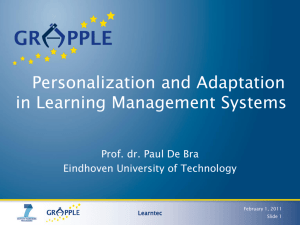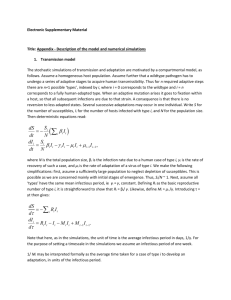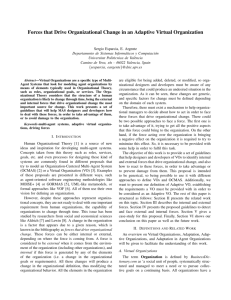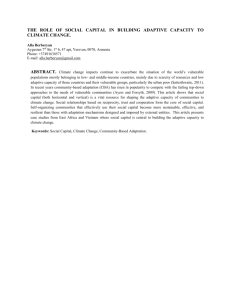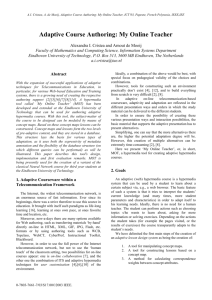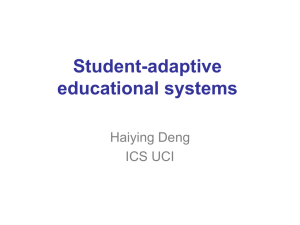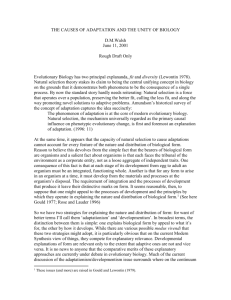Change Management-MBA625 LECTURE # 13 FOOTNOTES TO
advertisement
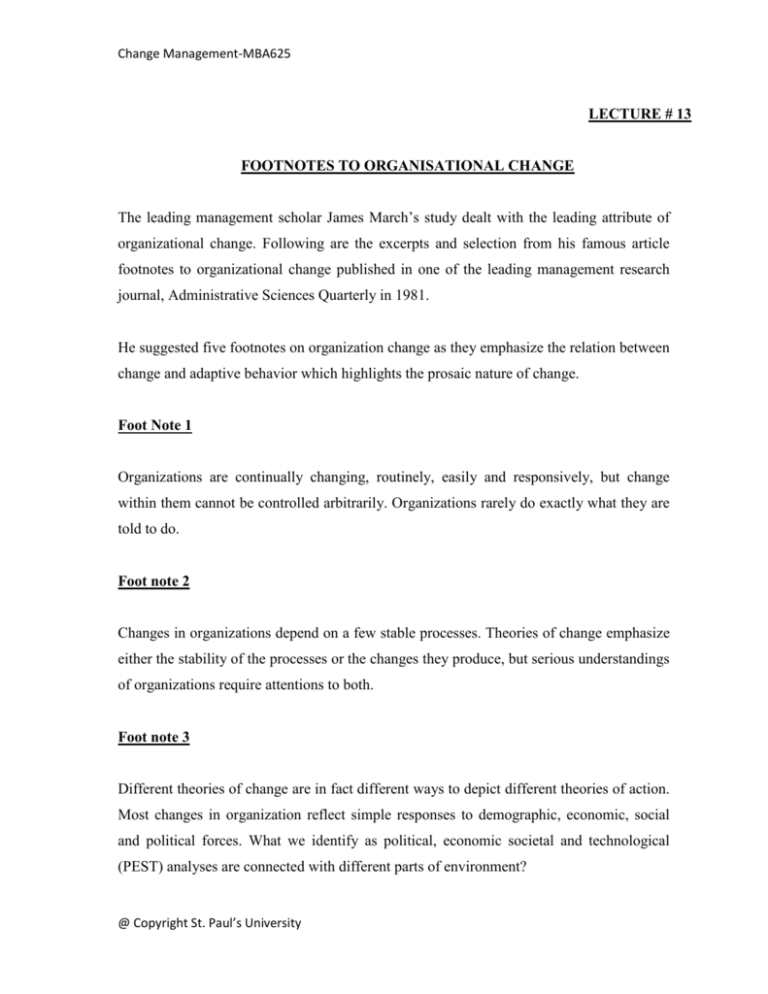
Change Management-MBA625 LECTURE # 13 FOOTNOTES TO ORGANISATIONAL CHANGE The leading management scholar James March’s study dealt with the leading attribute of organizational change. Following are the excerpts and selection from his famous article footnotes to organizational change published in one of the leading management research journal, Administrative Sciences Quarterly in 1981. He suggested five footnotes on organization change as they emphasize the relation between change and adaptive behavior which highlights the prosaic nature of change. Foot Note 1 Organizations are continually changing, routinely, easily and responsively, but change within them cannot be controlled arbitrarily. Organizations rarely do exactly what they are told to do. Foot note 2 Changes in organizations depend on a few stable processes. Theories of change emphasize either the stability of the processes or the changes they produce, but serious understandings of organizations require attentions to both. Foot note 3 Different theories of change are in fact different ways to depict different theories of action. Most changes in organization reflect simple responses to demographic, economic, social and political forces. What we identify as political, economic societal and technological (PEST) analyses are connected with different parts of environment? @ Copyright St. Paul’s University Change Management-MBA625 Footnote 4 Although org. response to environmental events is broadly adaptive and mostly routine based, the response takes place in a confusing world. As a result prosaic (characterless) processes sometimes have surprising outcomes. Footnote 5 Adaptation to changing environment involves and interplays of rationality and foolishness. Organization foolishness is not maintained as conscious strategy, but embedded in such organizational anomalies as slack, managerial incentives, symbolic action, ambiguity and loose coupling. Stable Processes of Change One view is that change fails not because organizations are rigid and inflexible but they are impressively imaginative. According to Aldrich in most organization failure occur early in life when organizations are small and flexible, not later. There is considerable level of stability in organization and organizations are remarkably adaptive as enduring institutions, respond to volatile environments easily, though not optimally. We are inclined to look for most dramatic explanations for change, is our common mistake. Most changes in organizations result neither from organization processes or forces, nor from uncommon imagination but from relatively stable, routine processes that relate organization to their environments. Many of the most stable procedures in an organization are procedures for responding to economic, social and political contexts. The routine processes of organizational adaptation are little complex, and a theory of change must take into account how these processes can produce unusual patterns of action. Therefore theory of organization change should not be different from a theory of ordinary action. Therefore research on organization as routine adaptive systems emphasize six (06) basic @ Copyright St. Paul’s University Change Management-MBA625 perspectives for interpreting organization action which are as under: 1. Rule following 2. Problem solving 3. Learning 4. Conflict 5. Contagion 6. Regeneration 1. Rule Following Application of standard operating procedures (SOPs), duties, obligation, roles, rules, and criteria evolve through competition and survival, and those followed by organizations that survive, grow and multiply come to dominate the pool of procedures 2. Problem Solving Action can be seen as problem solving. The underlying process involves choosing among alternatives by using some decision rule that compares alternatives in terms of their expected consequences. It is the rational actor model which prevails in organizations. Managers make rational choice under certain conditions of risk and cost-benefit analyses. 3. Learning Action can be seen as stemming from past learning. The underlying process is one in which an organization is conditioned through trial and error to repeat behavior that has been successful in the past, and to avoid that has been unsuccessful. Learning is what can be identified as experiential in nature. 4. Conflict @ Copyright St. Paul’s University Change Management-MBA625 Action can be seen as resulting from conflicting among individuals or groups representing diverse interests. The underlying process is one of confrontation, bargaining and coalition, in which outcomes depend on the initial preferences of actors weighted by their power. Edgar Schein talked of negotiated order to exist in context of organization. Changes result from shifts in the mobilization or in the resources managers’ control. This change is again a negotiated one by different members of organization who want to adjust policies as per their understanding view and influence in organization. This model is the one based on politics. Members of organization interact in a political manners and change results in a politically negotiated settlement amongst them. Another view relates to the pecking order in organization – explains the existence of hierarchical or top down order in organizations. 5. Contagion Action can be seen as spreading from one organization to another. The underlying processes is one in which variations in contact among organizations and in the attractiveness of the behavior or beliefs being imitated affect the rate and pattern of spread. 6. Regeneration Action can be seen as resulting from the intentions and competencies of organization actors. Turnover in organization introduces new members with different attitudes, abilities and goals. This resembles organization life cycle approach and is quite like birth, growth, maturity and decline. An organization uses rules, problem-solving, learning, conflict, contagion, and regeneration to cope with its environment and actively adapt to it. The processes are conservative that is they tend to maintain stable relations, sustain existing rules, and reduce differences among organizations. The above six processes are neither esoteric (mysterious), complicated nor mutually exclusive. @ Copyright St. Paul’s University Change Management-MBA625 SOME COMPLEXITIES OF CHANGE The above six factors are closer to real life organizational dynamics; demonstrate the complexities of routines of real life. While he interaction amongst these five phenomenon makes change complex which are listed below: 1. Unanticipated Consequences of Ordinary Action 2. Solution Driven Problems 3. The Tendency for Innovation - And Organizations to Be Transformed During the Process of Innovation 4. The Endogenous Nature of Created Environment 5. The Interaction amongst System Requirements of Individuals, Organizations and Environments 1. Unanticipated Consequences of Ordinary Action First, the rate of adaptation may be inconsistent with the rate change of environment. Unless an environment is perfectly stable, organization cannot learn appropriately. This means organization always lag behind environment. Where an environment changes quickly relative to the rate of organization adaptation, the process of adaptation can easily lose its sense to be sensible and relevant. At times organization anticipates ahead of time. Example can be given from marketing. A product was launched by one sugar firm in Pakistan as liquid sugar. The idea seems too fine and advanced a concept but failed miserably given the cultural context of Pakistani society. Similarly, some products that are technologically too advanced also liable to fail because they are ahead of time. Similar is the case with changing organization strategy and organization when situation/ time or environment /market are not mature enough to absorb change. Therefore, it is possible for an anticipatory process (problem-solving) to result in changes that out runs the environment and thereby become unintelligent. Second, the causal structure (cause and effect as seems obvious to us to external) may be different from that is @ Copyright St. Paul’s University Change Management-MBA625 implicit in the process. While changing through following and imitating we tend to focus external effects and ignore causal links which are benign or hidden. Since we have an incomplete picture or false model of causality, therefore eventually change can result in unanticipated outcomes. Third concurrent or parallel processes (changes at times stay parallel) appear to carry sense may combine to produce joint outcome that are not intended by any one, and counter the interests motivating the individual action. For example the retention of a manual system besides going for the automated (new) one. Though avoided but these unanticipated outcomes are quite common. Examples – Competency Multiplier Organizations have procedure to involve relevant people in processes such as decisionmaking, planning, budgeting or the like. Individual vary in their knowledge, skills and interests about a problem. Initial participation rate vary and participating individual turn out to be slightly more competent than others. This induces them to become even more competent. Before long, the de facto composition of the group can change dramatically (than initially conceived). More generally organizations learn from experience, repeating actions that are successful. As a result they gain greater experience in areas of success than in areas of failures. This seems sensible and logical. The sensibleness of such specialization depends on the learning rate and rate of change in environment. The process can easily lead to misplaced specialization if there are infrequent, major shifts in the environment (increased specialization lead to increased dependence and hence org. is vulnerable to change) Another example of unexpected outcome from org. routines is related with satisficing behavior of individual and organization. According to March and Simon, organization seek alternatives that will satisfy target goal rather than to look for the alternative with the highest possible value. Satisficing organization can be viewed as the organization which tries to maximize the probability of achieving targets. But it is not necessary to assume that satisficing organization will follow decision rules, that are, risk avoiding in good times, and, risk-seeking in bad times. For e.g. organization that are facing bad times will follow riskier means and riskier strategies, thus simultaneously increasing the chances of their @ Copyright St. Paul’s University Change Management-MBA625 survival through the present crisis and reducing their life expectancy simultaneously. As a result organization efforts to survive in fact speed up the process of failure. Riskseeking behavior transformation, that needs some qualification, experience and mindset to manage risk which was never cultivated earlier in organizations. Second, most of the time organization exhibit risk-avoiding behavior by its very nature. Because, if organization goals vary with organization performance and performance of comparable organizations, then most organization will be termed reasonably good most of the time. The above example depicts how routine can lead to un-intended surprise outcome Another example identified is of performance criteria. An organization measures the performance of its participants. Common criteria for business firms are to reward their managers on the basis of calculation of profits warned by different parts of the organization. The performance-reward linkage is to be made precise and visible for organizational control purposes as well. However this practice may lead to ignore long term consequences for organization since it is more efficient in short term because efforts are devoted to accounts rather than to performance. This may lead the participants to manipulation and maneuvering in organization. Superstitious Learning Organizations learn from their experience, repeating actions associated with good outcomes and avoiding actions associated with bad outcomes (Learning by association phenomenon or conditioning). This is successful in stable world. But the world is not so simple and stable all the time, experiential learning can result in superstitious learning. Example reported one author here is of pilots. The trainers reward pilots who make good landings and punishing pilots who makes bad ones. They observe that pilots who are punished generally improve on the subsequent landings, while pilots who are praised generally do worse. Thus they learn that negative reinforcement works better than the positive one. The learning is natural but the experience is a confounded one. Let me quote my own experience here about students. Students who perform better in the preliminary examination and get rewarded well will tend to perform mediocre in the subsequent @ Copyright St. Paul’s University Change Management-MBA625 examination as against the one who performs average in the preliminary examinations and improves more in the subsequent emanations. Hence these examples illustrate the variation in behavior generated by adaptive processes in a typical organization conditions which can lead to surprising outcomes. 2. Solution Driven Problems Good examples for solution driven problems exist in our society. You can observe this in real life. For instance go to doctor and you will find long, comprehensive multidimensional prescription at hand. The solution is already with him without even giving listening appropriately to his patient. If you go to computer technologist for problem solving with software or system etc., the solution presented will be to reconfigure the whole system/ window etc. In office meetings bosses or heads of department or organizations frequently come up with statements starting with you all .All such scenarios refer to the tendency to have a generalized solution in prior. According to Cyert and March, “There is ample evidence of when organization performance fails to meet objective then it search for new solution, that is new ways of doing things as changes often seem to be driven less by problems than by solutions.” Why this is so? Because organizations face a large number of problems of about equal importance, but only a few solutions. Thus the chance of a solution to a particular or unique problem is small. Consequently organization scans for solutions rather than problem, and matches any solution found with some relevant problem. Second reason is the linkage between individual solutions and individual problem is often difficult to make unambiguously especially when causality and technology are ambiguous. Therefore what we observe will be predicted by knowledge of solutions than by knowledge of problems. Imperatively professional change their procedures and introduce new technologies because they have knowledge of it. An organization that is modern adopts new things because that is what being modern means. When a major stimulus for change comes from a sense of competence, problems are created in order to solve them, and solutions and opportunities stimulate awareness of previously un-salient or unnoticed problems or preferences. @ Copyright St. Paul’s University Change Management-MBA625 3. The Tendency for Innovation - And Organizations to Be Transformed During the Process of Innovation It is observed that both innovations and organizations tend to be transformed during the process of innovation. Different and multiple meanings exist for the intended change in the organization and hence the standardization of meanings of change is a problem owing to inappropriate strategy or poor analysis It is also a common problem that change policy or program gets started with some intent and eventually end up with something else because of the fundamental ways in which changes are transformed by the process of change. Organization also gets transformed in the process. Organizations develop and redefine goals while adapting to environmental pressure; minor changes can lead to larger ones, and initial intent can be entirely lost 4. The Endogenous Nature of Created Environment General assumption is organization takes action due to environmental pressure, and that environment is not influenced by organizational actions. But organizations create environment as well, and the resulting complications are significant. For e.g. action of one competitor becomes an environment of another, therefore each competitor determines its own environment. For example an executive of a leading shoe firm revealed why their firm does not charge higher prices despite producing a quality product of international standards? Because this will become an industry standard and other competitors will follow without delivering the same quality. This type of behavior is in line with corporate social responsibility. Hence adaptation is not learning about fixed environment but is to deal with continuously changing. Therefore organizations are quite capable of influencing and creating their own environment by the way they interpret and act in a confusing world. So what happens practically is that small signals out of routine or adaptive processes get echoed back to organization (through environment) in an amplified manner, and hence may result in changing organization simultaneously and endogenously @ Copyright St. Paul’s University Change Management-MBA625 5. The Interaction amongst System Requirements of Individuals, Organizations and Environments Though this is oversimplification, nonetheless, it is possible to see an organization as an intermeshing of three systems: individuals, collection of individuals (which is organization) and environment (which is collection of organization). Conflicts might exist in the demands of these three. While classical literature focuses on making individual and organization demands compatible, but in the analysis of organization change it seems that individual in organization and organization itself has different requirements in the collection of organization (which is environment). The question is how to place all three in equilibrium? Finally organization is complex combination of activities, purposes and meanings. Even impressive integration of formal organization, should not however, obscure the many ways in which organization is loosely coupled. Behavior is loosely coupled with intentions, and intentions are loosely couple with actions; actions in one part of the organization are loosely coupled with actions in another part; actions of today are loosely coupled with actions of tomorrow. Such loose coupling does not appear to be avoidable. These do not relate to theory but pertains to adaptive process of change. @ Copyright St. Paul’s University Change Management-MBA625 @ Copyright St. Paul’s University Change Management-MBA625 @ Copyright St. Paul’s University Change Management-MBA625 @ Copyright St. Paul’s University



